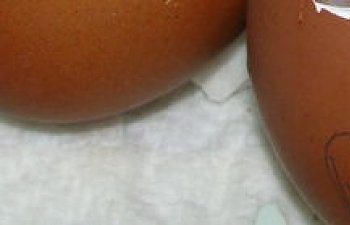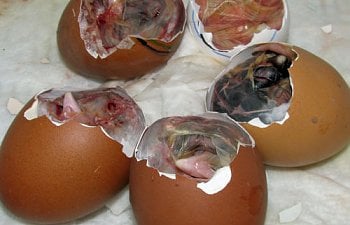The most common causes of malpositions and deformities in chick embryos
Studies have found that the incidence of embryos unable to hatch due to malpositions varies from 1.2 to 1.8%, with an average of 1.5%. Malpositioned embryos are often unable to pip the eggshell and/or are able to pip, but unable to hatch, due to improper positioning within the egg. The most common malpositions are:
- Head between thighs
- Head in the small end of the egg
- Head under the left wing
- Head not directed toward air cell
- Feet over the head
- Beak above the right wing
If a chick embryo is provided with the correct environment (correct temperature, humidity, and adequate rotation of the egg) it will position itself around 17-18 days of incubation for the hatch. The correct position is with the head tucked under the right wing, with the head directed toward the air cell, which should be in the large end of the egg. However, due to internal and external factors the embryo sometimes fails to do this. There are numerous reasons that malpositions occur. The common reasons for incidences of malpositions are:
- Eggs were set upright, with the small end up. Eggs placed upright in the incubator should always be set with the large (air cell) end up.
- Advancing breeder hen age and shell quality problems.
- Egg turning frequency and angle were not adequate. Regular turning of the egg through a minimum 45-degree angle assists the embryo to position for the hatch. Eggs should be turned at least 3 times daily, though more is better.
- Inadequate percent humidity loss of eggs in the setter. Acceptable weight loss of eggs during incubation is 11-14%.
- Inadequate air cell development, incorrect temperature, and humidity regulation, and insufficient ventilation in the incubator.
- Imbalanced feeds, elevated levels of mycotoxins, and vitamin and mineral deficiencies.
- Exposure to lower than recommended temperatures in the last stage of incubation.
- Round shaped, or overly large eggs.
- Eggs handled or stored improperly.
Common embryo deformities and causes
Chick embryo malformations are mostly caused by incorrect feeding of the breeder flock, resulting in poor quality hatching eggs, or incorrect incubator settings. For a breakdown of the effect of incorrect nutrient levels on embryo development see this article. The most common malformations seen in chicks are:
- Beak abnormalities, such as crossed beak, parrot beak, or short upper beak, can be a result of genetic traits, poor hen nutrition, exposure to pesticides, hatching eggs exposed to near-freezing temperatures.
- Small or missing eye(s), which is normally a result of high temperature during incubation, especially during the early stages.
- Exposed brain, which is normally a result of high temperature or prolonged heat spikes during the early stages of incubation.
- Intestines outside of the abdomen, which can be a result of high temperature during mid-incubation, or hatching eggs exposed to near-freezing temperatures.
- Crooked (wry) neck, which can be either an inherited genetic trait or a result of poor breeder nutrition
- Crooked toes, foot, and leg problems, which can be a result of excessive inbreeding, poor breeder nutrition, or an inherited genetic trait.
Suggested further reading:


